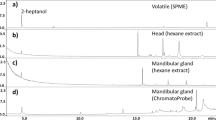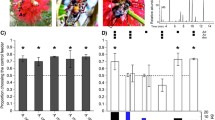Abstract
Life in insect societies asks for a permanent flow of information, often carried by rather simple organic molecules. Some originate from plants as odours of blossoms or exudates from trees. Especially important are the intra- and interspecific combinations of compounds produced by the insects themselves. These are called pheromones or ecto-hormones and serve a variety of tasks. The paper deals mainly with honeybee pheromones, but takes also into consideration those of wasps and hornets. Effects of pheromones are monitored ethologically by direct observation and filming as well as in a more quantitative manner with using direct and indirect calorimetry. In all experimental set-ups alarm pheromones were used as controls. They show an up to fourfold increase of activity after a few seconds, determined for small groups of insects as well as for a whole hornet nest placed in a 25-l calorimeter. A variety of cosmetics like soaps, shampoos, lotions and perfumes are included in the investigations because of repeated reports about unwarranted insect attacks which are said to be provoked by such products. None of the applied substances provoked a significant reaction of the bees (p > 0.05). A short appendix discusses the still questionable existence of pheromones in man, which were confirmed under laboratory conditions, but not yet for daily life.







Similar content being viewed by others
References
Agosta WC (1992) Chemical communication: the language of pheromones. Scientific American Library, New York
Bargmann CI (2006) Comparative chemosensation from receptors to ecology. Nature 444:295–301
Bertsch A (1975) Blüten—lockende Signale (Blossoms—enticing signals). Otto Maier Verlag, Ravensburg
Dettmer K, Peters W (2003) Lehrbuch der Entomologie, 2nd edn. Springer, Berlin
Edwards R (1980) Social wasps. Restokil Limited, East Grinstead
Fahrenholz L, Lamprecht I, Schricker B (1989) Microcalorimetric investigations of the energy metabolism of honeybee workers, Apis mellifera carnica. Thermochim Acta 151:13–21
Fahrenholz L, Lamprecht I, Schricker B (1992) Calorimetric investigations of the different castes of honey bees, Apis mellifera carnica. J Comp Physiol B 162:119–130
Fink B, Sövegjarto O (2006) Pheromone, Körpergeruch und Partnerwahl. Gynäkologe 39:731–740
Free JB (1987) Pheromones of social insects. Cornell University Press, Ithaca
Grammer K, Fink B, Neave N (2005) Human pheromones and sexual attraction. Eur J Obstet Gynecol Reprod Biol 118:135–142
Hatt H (2004) Molecular and cellular basis of human olfaction. Chem Biodivers 1:1857–1869
Karlson P, Lüscher M (1959) Pheromones: a new term for a class of biologically active substances. Nature 183:55–56
Kohl JV, Atzmueller M, Fink B, Grammer K (2001) Human pheromones: integrating neuroendocrinology and ethology. Neuroendricronol Lett 22:309–321
MacLean C, Schmolz E (2004) Calorimetric investigations on the action of alarm pheromones in the hornet Vespa crabro. Thermochim Acta 414:71–77
Monti-Bloch L, Diaz-Sanchez V, Jennings-White C, Berliner DL (1998) Modulation of serum testosterone and autonomic function through stimulation of the male human vomeronasal organ (VNO) with pregna-4,20-diene-3,6-dione. J Steroid Biochem Mol Biol (England) 65(1–6):237–242
Moritz R, Bürgin H (1987) Group response to alarm pheromones in social wasps and the honeybee. Ethology 76:15–26
Moritz RFA, Southwick EE (1992) Bees as superorganisms—an evolutionary reality. Springer, Berlin
Nachtigall W, Blüchel KG (2000) Das große Buch der Bionik—Neue Technologien nach dem Vorbild der Natur. Deutsche Verlags-Anstalt, Stuttgart
Ono M, Terabe H, Hori H, Sasaki M (2003) Components of giant hornet alarm pheromones. Nature 424:637–638
Schmidt JO (1998) In: Vander Meer RK, Breed MD, Espelie KE, Winton ML (eds) Pheromone communication in social insects. Westview Press, Boulder
Schmolz E (1997) Kalorimetrische Untersuchungen zu Wärmeproduktion und Thermoregulation der Hornisse Vespa crabro L.: Energieumsatz im Nest, bei der Überwinterung und im Flug (Calorimetric investigation on heat production and thermoregulation of the hornet Vespa crabro L.: Energy turnover in the nest, during hibernation and during flight). Dissertation Fachbereich Biologie, Freie Universität, Berlin
Schmolz E, Lamprecht I (1999) Calorimetry of small animals. In: Kemp R (ed) Handbook of thermal analysis and calorimetry. Life sciences. vol 4, chap. 8. Elsevier Science, Amsterdam, pp 405–467
Schmolz E, Lamprecht I (2004) Thermal investigations on social insects. In: Lörinczy D (ed) The nature of biological systems as revealed by thermal methods. Kluwer Academic Publishers, Dordrecht, pp 251–283
Schmolz E, Scholz T, Lamprecht I (1999a) Alarmpheromone bei sozialen Insekten. Nachr Chem Tech Lab 47:1095–1098
Schmolz E, Brüders N, Schricker B, Lamprecht I (1999b) Direct calorimetric measurement of heat production rates in flying hornets (Vespa crabro; Hymenoptera). Thermochim Acta 328:3–8
Shepherd GM (2006) Smells, brains and hormones. Nature 439:149–150
Southwick EE, Moritz RFA (1985) Metabolic response to alarm pheromone in honey bees. J Insect Physiol 31:389–392
Van der Goes van Naters W, Carlson JR (2006) Insects as chemosensors of humans and crops. Nature 444:302–307
Vareschi (1971) cited after Dettmer K, Peters W (2003) Lehrbuch der Entomologie, 2nd edn. Springer, Berlin
Veith HJ, Koeniger N, Maschwitz U (1984) 2-Methyl-3-butene-2-ol, a major component of the alarm pheromone of the hornet Vespa crabro. Naturwissensch 71:328–329
Von Frisch K (1967) The dance language and orientation of bees. Harvard Univ Press, Cambridge
Williams IH, Pickett JA, Martin AP (1982) Nasonov pheromone of the honeybee Apis mellifera L. (Hymenoptera, Apidae). J Chem Ecol 8/2:567–574
Winston ML (1987) The biology of the honey bee. Harvard Univ Press, Cambridge
Winston ML (1992) The biology and management of Africanized honey bees. Ann Rev Entomol 37:173–193
Wysocki CJ, Preti G (2004) Facts, fallacies, fears, and frustrations with human pheromones. Anat Rec Part A 281A:1201–1211
Acknowledgments
One of the authors (I. L.) acknowledges with pleasure the intensive discussion and the stimulating questions to this topic at the MolRec2007 Conference in Pecs/Hungary directly after the lecture and at later occasions. Our thanks go to Professor E. Battley, Stony Brook for his support of this manuscript.
Author information
Authors and Affiliations
Corresponding author
Additional information
Regional Biophysics Conference of the National Biophysical Societies of Austria, Croatia, Hungary, Italy, Serbia, and Slovenia.
Electronic supplementary material
Below is the link to the electronic supplementary material.
Supplementary data (WMV 3.96 Mb)
Appendix 1
Appendix 1
With respect to pheromones, the question often arises if pheromones—which are known from unicellular yeast cells up to all classes of animals—do exist for humans too. This question is still under discussion with many hints that pheromones are important for humans also, mainly in a sociosexual context (Hatt 2004; Wysocki and Preti 2004; Shepherd 2006). After an early rather vague discussion in the book of Agosta (1992) more recent reviews (Kohl et al. 2001; Grammer et al. 2005; Fink and Sövegjarto 2006) present different aspects of their origin, detection and effects. Human apocrine glands are supposed to be the main producer of pheromones. They are located in the axillae pits and the pubic region. The fact that a functional vomeronasal organ directly connected with the limbic system exists in humans also supports the idea of pheromone activities (Monti-Bloch et al. 1998).
Axons of the receptor cells in the vomeronasal organ directly lead to the bulbus olfactorius which projects into the limbic system. Thus, the information may be received unnoticed by us. Whether the pheromones may act along this line is still discussed (Fink and Sövegjarto 2006). Nevertheless, Grammer and colleagues wrote that “human sociosexual interactions are influenced by pheromones, even if they cannot be detected consciously” (Grammer et al. 2005).
The androstenol-androstenone-signalling system is a special focus of research. It was concluded that “… the model of humans being primarily visual creatures may require some reconsideration. Human life and interactions are influenced by pheromones whether or not affect or effect is part of our consciousness.” and “Human pheromones have more potential than any other social environmental sensory stimuli to influence physiology and, therefore, behaviour.” (Kohl et al. 2001). Nevertheless, doubts still exist because convincing results were only obtained under laboratory conditions until now, but not in real life. It needs carefully chosen experimental conditions to detect a—presumably weak—influence of human pheromones and body odour on the sociosexual behaviour and to prove efficacy of the commercial so-called sexual attractants (Fink and Sövegjarto 2006).
Rights and permissions
About this article
Cite this article
Lamprecht, I., Schmolz, E. & Schricker, B. Pheromones in the life of insects. Eur Biophys J 37, 1253–1260 (2008). https://doi.org/10.1007/s00249-008-0263-6
Received:
Revised:
Accepted:
Published:
Issue Date:
DOI: https://doi.org/10.1007/s00249-008-0263-6




